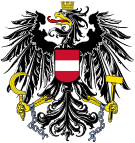| |||||||||||||||||||||||||||||||||||||||||||||||||||||||||||||||||
165 seats in the National Council of Austria 83 seats needed for a majority | |||||||||||||||||||||||||||||||||||||||||||||||||||||||||||||||||
|---|---|---|---|---|---|---|---|---|---|---|---|---|---|---|---|---|---|---|---|---|---|---|---|---|---|---|---|---|---|---|---|---|---|---|---|---|---|---|---|---|---|---|---|---|---|---|---|---|---|---|---|---|---|---|---|---|---|---|---|---|---|---|---|---|---|
| |||||||||||||||||||||||||||||||||||||||||||||||||||||||||||||||||
 Results of the election, showing seats won by constituency and nationwide. Constituencies are shaded according to the first-place party. | |||||||||||||||||||||||||||||||||||||||||||||||||||||||||||||||||
| |||||||||||||||||||||||||||||||||||||||||||||||||||||||||||||||||
| This article is part of a series on the |
| Politics of Austria |
|---|
 |
Parliamentary elections were held in Austria on 9 October 1949. About 500,000 registered Nazis, who were not allowed to vote in 1945, regained their voting rights. A newly created party, the Electoral Party of Independents (WdU) (a predecessor of the Freedom Party of Austria) specifically targeted this group of voters and immediately won a large share of votes.[1] The Austrian People's Party remained strongest party, although losing their absolute majority of seats. Leopold Figl stayed as Chancellor, leading a coalition with the Socialist Party of Austria as junior partner.[2]
- ^ The Development of Right-Wing Extremism After 1945 Documentation Archive of Austrian Resistance
- ^ Austrian Cabinets since 1945 Austrian Chancellery




